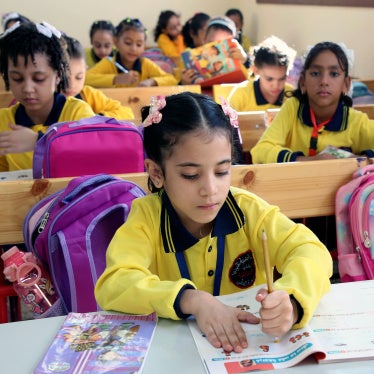“Now that I can’t go to school, it’s a tough situation,” 16-year-old Rasha told Human Rights Watch. “When I picture my future, I see nothing.” Rasha fled from Syria to Turkey in August 2013, but was unable to enroll in school in Turkey because she didn’t have the required residency permit.
Forcibly displaced children, including refugees, have the right to quality secondary education without discrimination. But the UN refugee agency estimates that globally, 75 percent of secondary school-age refugees are out of school. In some countries like Lebanon and Pakistan, just 5 percent of refugees attend secondary school.
The lack of access to secondary education for displaced children is a human rights crisis. Kids who drop out may end up engaged in hazardous labor or face child marriage, sexual violence, harassment by state security forces, and targeting and recruitment by armed groups.
Girls especially face barriers to secondary school in times of crisis. Sexual and gender-based violence, as well as early marriage and pregnancy, can further exacerbate these barriers. Just 7 girls for every 10 refugee boys attend secondary school globally.
Secondary education is clearly in kids’ best interest. Evidence shows that children who attend secondary school are often healthier, and more likely to find work, escape poverty, and have expanded opportunities as adults. Schools can protect kids, offer stability, and provide the tools to build a brighter future.
Why, then, are so few displaced children able to access secondary education?
A common problem is that many host countries’ education systems impose stringent and unnecessary demands for documentation in order for displaced children to attend secondary school. In Lebanon, Syrian refugee children are often required to provide transcripts to enroll in secondary school – documents often left behind by families fleeing their homes. Syrian refugee children in Turkey are required to obtain an identification document to enroll in schools but it can take half a year for the government to issue one—precious lost time for a student.
Poverty can also keep kids out of school. Many refugee families deplete their savings and are denied the opportunity to work legally, leaving them unable to afford secondary-school fees, uniforms, notebooks, and transport costs.
And crisis-response plans too often put secondary education on the back burner, even though refugees consistently identify education as a critical need. Globally, less than 2 percent of donor support goes to education in emergencies, and of that, far more goes to primary than secondary education. The fickleness of humanitarian funding – most grants last only 12 months, and long-term conflicts are sometimes permanently underfunded – can skew against well-resourced secondary education programs.
Government and humanitarian actors should closely examine the key factors that cause older displaced children, including girls, and children with disabilities, to drop out of school.
They should urgently take steps to eliminate these barriers, and include secondary education as a crucial component of crisis-response plans. Wherever possible donors should commit transparent, sustained, multi-year funding to ensure that children can access and complete secondary school.
Host countries should include refugee children in their national education plans. Some ways forward may include accommodating flexible enrollment for refugee children, offering placement exams instead of requiring transcripts, and de-linking immigration-related requirements such as residence permits from school enrollment criteria.
Education is a fundamental right, but we are failing secondary-school aged children in crises. We need to work much harder, so that when these children picture their futures, they can start seeing opportunities.








